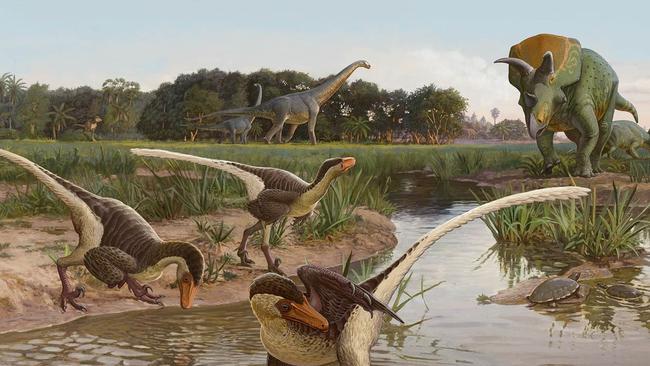Fossil leads to a clawed killer that could outrun them all
Scientists working in the US have found fossils of a swift primeval predator with killer claws that died after a brutal brawl.

Scientists working in the New Mexico badlands found fossils of a swift primeval predator with killer claws that died after a brutal brawl 67 million years or so ago, in the twilight of the dinosaurs, according to a new research report.
With feathered forearms and a whippy tail to steady it, the 2m-long creature may have been as agile as a cheetah in sprinting after prey, the scientists said.
“If you saw it alive, (it) would have looked like a weird toothy bird that could gut you with its foot claws,” said Steve Brusatte, a paleontologist at the University of Edinburgh, who wasn’t involved in the find.
Belonging to a previously unknown species, the discovery offers a rare glimpse of evolution on the eve of a cosmic disaster, in the final eons before an asteroid smashed into Earth at the end of the Cretaceous period and killed off much of life, several paleontologists who study the rise and fall of the dinosaurs said.
Scientists documented the find on Friday in the journal Scientific Reports.
While fragmentary, the discovery adds to evidence that many species of the time were in flux, as thunder-footed behemoths, including long-necked, tree-topping sauropods and carnivorous giants like Tyrannosaurus rex, were overtaken by smaller, more nimble denizens.
“We were getting smaller, possibly more sophisticated animals,” said Philip Currie, a paleontologist at the University of Alberta, in Canada, who wasn’t part of the research team.
“Clearly there was something going on.”
The new specimen first surfaced in 2008. Steven Jasinski, acting curator of paleontology at the State Museum of Pennsylvania, in Harrisburg, was prospecting for fossils with his colleagues south of Farmington, New Mexico, and spotted a square metre or so of tiny bone fragments in the sandstone.
“One fragment stood out,” Dr. Jasinski said. “It was a fossil claw.”
All told, it took Dr Jasinski four years of fieldwork to uncover all the remains, and then dozens of studious forays into museum fossil collections to properly identify the find. They categorised it as a separate species among the same family of predators as the Velociraptors of Jurassic Park film fame.
The scientists named the species Dineobellator notohesperus — “western warrior” — by combining terms from Navajo, Greek and Latin. Based on the partial skeleton they unearthed, the scientists said the Dineobellator was about 2m long and stood 1.2m tall at the hip.
Its hands and feet featured rakes of 15cm claws. Its forearms and hands were unusually powerful, possibly giving it the strength to seize and drag down much larger animals, they said.
An examination of its forelimbs revealed a half-dozen knobs of bone where feathers had been attached. “This is proof that this raptor had feathers,” said Dr Brusatte.
Unlike other similar carnivorous dinosaurs, the Dineobellator’s tail was flexible and likely counterbalanced its body as the creature twisted and turned as it ran. “Its tail was essentially held straight out and could whip around like crazy,” Dr Jasinski said. “This suggests this animal was very agile and would have been a pursuit predator.”
The fossils also revealed evidence of a hard life. One rib had broken and then healed. An unhealed gouge along a forearm resembled a claw mark, they said.
“That suggests that this one probably got in a fight with a member of the same species,” Dr Jasinski said. “That injury would have occurred close to or at the time of death.”
The Wall Street Journal



To join the conversation, please log in. Don't have an account? Register
Join the conversation, you are commenting as Logout